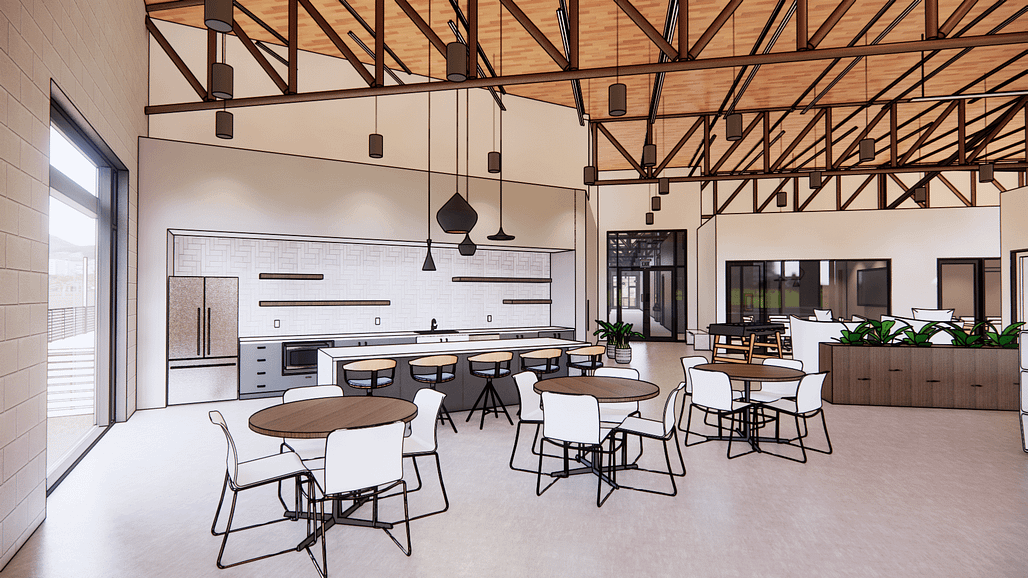By Laura Vierling, MCR, IIDA, LEED AP, PROSCI CP; Ian Reves, AIA, IIDA, WELL AP; Julia Leahy, IIDA, NCIDQ, LEED AP ID+C; Melissa Panara, NCIDQ, LEED AP

What is the Attraction?
With good reason, spec suites are trending in today’s corporate real estate environment. They are a ready product when speed to market is critical. And as they say…seeing is believing! A potential tenant can walk in, test drive a suite, and take immediate possession. With an 80% to 90% buildout, the remaining 10% to 20% of construction can incorporate a tenant’s brand and persona within a matter of weeks. And given post-pandemic supply chain delays that remain in some parts of the country, leasing a property already built is a fail-safe strategy.
How Does it Work?
Establishing the bones and just enough detailing to inspire potential tenant interest and imagination is the owner’s/developer’s task. Walking a client through a spec suite complemented by thoughtful renderings or even virtual reality experiences provides opportunities to point out options, especially if the space is at 50% buildout. However, the less built, the more a tenant can control and dictate desired features.
Once the lease is signed, a 10 to 12-week buildout is far more attractive than 18 to 20 weeks of heavy construction or major work on the infrastructure. And it is possible for a tenant to occupy some or all of the suite as the buildout is finalized. A preselected furniture vendor that can quickly ship a client’s choices is an additional advantage.
Staging is an important factor that brings a potential tenant’s brand and culture into the spec suite for a more personalized experience. Furthermore, the buildout complemented by an immersive VR version of the suite creates a powerful combination for ease of collaboration and customization. In this case, the owner/developer would have to fund both.

Strategic Considerations
Highly desirable markets tend to quickly move spec suites if they are built. Secondary markets leverage the spec suite as a tool to stimulate interest. But if a spec suite sits empty too long, no matter how compelling the design, it could indicate that the building, adjacent property, or site access is not ideal.
Critically, owners/developers need to thoroughly understand a spec suite’s target demographic. Some spec suites, products of significant investment, remain empty because they fail to resonate with an intended audience. But an owner might work with a finance team that directly interacts with potential tenants, understanding their needs and objectives. And for many owners/developers, the spec suite becomes a prototype they can market with the flexibility to easily modify as demographics and workplace needs change and evolve.
Today's Spec Suites
Historically spec suites have tended to be cheerful, vanilla, and relatively inexpensive—with an emphasis on paint and carpet. Today a bit more is needed to create a compelling space that supports the flight to quality. Over time, owners have come to understand that tenants are attracted to quality and, though adhering to responsible budgets, they are making the necessary investment in response to a more sophisticated and informed client.
For many enterprises it is no longer a matter of quantity. Even prior to the pandemic, more free-address workplaces were being designed, moving away from the 1:1 desk-to-employee ratio that is more prevalent now with the advent of hybrid-work environments. Perspective tenants want welcoming, high-performance spaces that attract employees to the office and boost recruitment. With significant inventories now in many markets, a space must be differentiated to create a lasting impression on potential tenants. Aesthetics and functional aspects are equally important, from acoustics to meeting spaces to flexibility and graphics. An investment in high-end finishes, fixtures, and features goes a long way toward that goal.
Achieving the right balance between cost, existing architecture, and added elements to attract tenants is challenging. There is no one size fits all approach to developing compelling spec suites. Although today’s spec suits tend to be smaller, if there is no construction solution to create a larger space, such as removing a demising wall, even a relatively small suite has the potential to captivate the vision of a potential client.

Full Floors and Hubs
For some of our clients, it is not just one or two spec suites on a couple of floors but a full floor of various-sized spec suites plus a common amenity hub. And that is a big difference from what we were seeing several years ago. The hub might include different types of meeting spaces, but always a coffee bar and a large space for events or entertaining. Wellness, prayer, and mother’s rooms might also be features, as well as a training room or conference center. Suites throughout the floor will share the hub, and rooms could be reserved. At Brookfield Properties, with whom we collaborate, Vice President, SPACE + Design | U.S. Tiffany Liam notes, “We believe that the experience of sharing an amenity space with other tenants adds to the draw of bringing people back into the office, that social connection. It also allows us to build space that tenants can use for events as well as having the capability of booking large meetings with clients. All without eating into their own suite area.”
Because of the required maintenance and concierge level of service, some owners are reluctant to build an amenity hub. Yet amenities are key. Is there a fitness center, dry cleaner, or places for lunch within walking distance or within the building? Our experience speaks to the power of amenities and location. Recently, for a property with great surrounding amenities, where a major corporation had leased half the building for its new headquarters, IA was designing thoughtful spec suites represented by high-end renderings. The owner started marketing the suites via the renderings and they were all leased just as construction was begun!
Innovation and Fresh Aesthetics
To attract and support tenants in a specific industry, we see a lot more targeted, purpose-designed spec suites intended to clearly demonstrate a property’s features and value. One of our clients is considering several suites designed for professional services tenants that include a slightly higher percentage of private offices and more refined client entertaining spaces. For another client, in an effort to diversify the property, we are designing spec suites that support a different tenant type than the property’s typical lessee.
The spec suite can also drive innovation in different markets. For instance, in the South, where the more traditional professional services are reluctant to realize the level of use and quality older properties offer, our Atlanta studio designed a spec suite demonstrating that post-industrial buildings, typically expected to house progressive, tech, or creative tenants, can, in fact, optimally support legal and professional services tenants.
And in high-growth areas outside the city center, our Charlotte studio reports a demand for the adaptive reuse of warehouses, with their industrial look and feel. These single and double-story brick buildings featuring raw materials and open decks are a big draw, moving away from the typical corporate high-rise towards a fresh aesthetic and experience with access to the outdoors, free parking, and walkable amenities. And they are leasing faster than we can build them!
Conclusion
The spec suite is a powerful means to quickly introduce a prospective tenant to the virtues and reality of an available property at a time like the present when speed to market is critical. Because it is built out, though not complete, it offers an immersive experience with a potential for branding and customization that requires minimal construction. Within weeks a tenant can be operating out of the new space benefiting its enterprise as well as the property owner/developer. We see spec suits as a winning proposition, trending in general and in particular at this time in Atlanta, Charlotte, Washington, DC, Seattle, and Houston.

Laura Vierling, MCR, IIDA, LEED AP, PROSCI CP
Principal, Managing Director, Washington D.C.
With 30 years of design experience and industry awards for an extensive range of industries—Corporate, Technology, Communications, Financial, Legal, Healthcare, Federal Government, and Non-Profits—Laura leads IA’s Washington, DC studio and Federal Government practice.

Ian Reves, AIA, IIDA, WELL AP
managing Director, Atlanta
Designing innovative solutions that draw on 20 years of experience, Ian curates high-performing projects centered on the human experience that engage, inspire, and enrich the community. i.reves@interiorarchitects.com

Julia Leahy, IIDA, NCIDQ, LEED AP ID+C
Design Director & Strategist, Boston
Collaborating with organizations for over 15 years, Julia designs transformative workplaces that best support work processes, culture, and the user experience.

Melissa Panara, NCIDQ, LEED AP
Design Director, Charlotte
For corporate, financial, professional services, retail, campus, and headquarters projects, Melissa excels in developing/maintaining long-term client relationships through an ability to innovate, inspire, and educate honed over almost 25 years.
